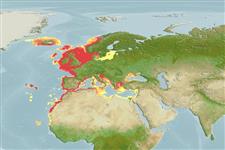Common names from other countries
Environment: milieu / climate zone / depth range / distribution range
Ecologia
; intervalo de profundidade 0 - 400 m (Ref. 78075), usually 15 - 50 m (Ref. 106788). Temperate, preferred 12°C (Ref. 107945); 68°N - 15°N, 32°W - 36°E (Ref. 113881)
Eastern Atlantic and the Mediterranean Sea. Temperate to polar.
Length at first maturity / Tamanho / Peso / Idade
Maturity: Lm ? range ? - ? cm Max length : 11.0 cm SHL macho/indeterminado; (Ref. 78075); Idade máx. registada: 8 anos (Ref. 8702)
Max depth range from Ref. 113966. Suspension feeder (Ref. 3477). Found on sand, mud, gravel; also associated with maerl beds and mussel beds (Ref. 114800).
Life cycle and mating behavior
Maturidade | Reprodução | Desova | Ovos | Fecundidade | Larvas
Members of the class Bivalvia are mostly gonochoric, some are protandric hermaphrodites. Life cycle: Embryos develop into free-swimming trocophore larvae, succeeded by the bivalve veliger, resembling a miniature clam.
Demir, M. 2003. (Ref. 2754)
Categoria na Lista Vermelha da IUCN (Ref. 130435)
Categoria CITES (Ref. 108899)
Not Evaluated
Not Evaluated
Utilização humana
Pescarias: espécies comerciais
FAO - Aquacultura: produção; pescarias: landings | FishSource | Sea Around Us
Ferramentas
Fontes da internet
Estimates based on models
Preferred temperature
(Ref.
115969): 7 - 15.9, mean 10.1 (based on 520 cells).
Resiliência
Elevada, tempo mínimo de duplicação da população menor que 15 meses (K=0.51-1.34; tmax=8).
Prior r = 0.56, 95% CL = 0.37 - 0.84, Based on 1 data-limited stock assessment.
Vulnerabilidade
Low vulnerability (22 of 100).
